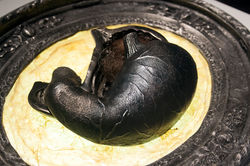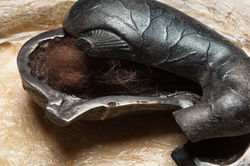CRISTIN MILLETT
 |  |  |
|---|
St. Elmo's Fire
6" x 16" x 18"
Cast iron, cast aluminum, gut, human hair
An extension of my research includes “sacred anatomy,” the pre-16th century practice of dismembering cadavers, particularly nobility and saints, in order to disperse the remains/relics for widespread worship of relics. This series of sculptures draws from Catholicism as a starting point, but the pieces were triggered by our current turbulent political climate. Threats to gender and racial equality, women’s empowerment, reproductive rights, voting rights, and intersectional human rights are shredding the fabric of society. Growing disparities permeate our daily lives, fueled by divisive speech and hateful actions. Through my work, I pose questions, raise awareness, and sound the alarm.
The legend of Saint Elmo claims that he continued preaching even after a lightning struck the ground beside him. As a result, he is the patron saint of sailors, who are in danger from sudden storms and lightning. Electrical discharges at the top of a ship’s mast were interpreted as a sign of his protection and are often called Saint Elmo’s Fire. He endured a range of torturous trials in an effort to force him to renounce his faith, finally succumbing to his death after his stomach was slit open and his intestines were wound around a windlass. “St. Elmo’s Fire” is comprised of a cast iron stomach encircled by a cast aluminum oval frame that has been covered in gut, or hog intestine, the same material used for sausage casing. The gut creates a visceral, body-like cavity to cradle the stomach. A cast iron stomach describes the stomach of a person who can eat or drink almost anything without getting sick. In recent years, I’ve become very aware of a sick feeling in my stomach. I’ve also had a strange sensation in my throat, like a cat with a hair ball trapped in its esophagus.